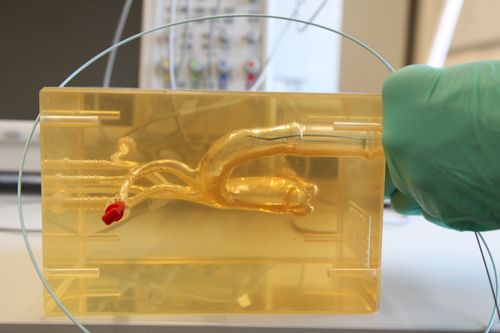MoBeStAn
- Project title: Modeling and Influencing Flows in Aneurysms
- Funding organisation: State of Saxony-Anhalt
- Funding period: 01.10.2008 until 01.09.2010
Aneurysms are balloon-like bulges in the arterial vessel walls. The rupture of these aneurysms leads to severe internal bleeding and can – depending on the affected vessel – lead to death within minutes: ruptured aneurysms always result in life-threatening hemorrhage.
The treatment of these bulges in the peripheral vascular system is generally the task of vascular surgery. The treatment of intracerebral aneurysms is now performed as minimally invasively as possible, as the results are better compared to open surgery. In this procedure, a catheter is advanced through the peripheral vascular system into the head and then into the interior of the aneurysm, which is filled with platinum wire (coiling) with the goal of reducing blood inflow into the aneurysm to the point that thrombosis and subsequently fibrosis of the aneurysm occur. A new therapeutic strategy is the insertion of implants such as stents into the parent vessel at the site of the aneurysm, so that the blood flow in the area of the bulge is qualitatively and quantitatively altered in such a way that the main blood stream bypasses the aneurysm, reducing the wall stress below the critical value.
Further information about the project can be found here.
- Projekttitel: Modellierung und Beeinflussung von Strömungen in Aneurysmen
- Fördermittelgeber: Land, Sachsen-Anhalt
- Förderungseitraum: 01.10.2008 bis 01.09.2010
Aneurysmen sind ballonartige Aussackungen der arteriellen Gefäßwände. Das Platzen dieser Aneurysmen führt zu starken inneren Blutungen und kann – abhängig vom betroffenen Gefäß – innerhalb von Minuten zum Tode führen: ruptierte Aneurysmen führen immer zu einer lebensbedrohlichen Hämorrhagie.
Die Behandlung dieser Aussackungen an Gefäßen im peripheren Gefäßsystem ist im Allgemeinen eine Aufgabe der Gefäßchirurgie. Die Behandlung von intrazerebralen Aneurysmen wird inzwischen möglichst minimal-invasiv durchgeführt, da die Ergebnisse im Vergleich zu einer offenen Operation besser sind. Dabei wird ein Katheter über das periphere Gefäßsystem in den Kopf und dann in das Innere des Aneurysmas vorgeschoben und dieses mit Platindraht ausgefüllt (coiling), mit dem Ziel, den Bluteinstrom in das Aneurysma soweit zu reduzieren, dass eine Thrombose und im weiteren Verlauf eine Fibrose des Aneurysmas eintritt. Eine neue Therapiestrategie ist das Einbringen von Implantaten wie z.B. Stents in das Trägergefäß auf Höhe des Aneurysmas, so dass der Blutfluß im Bereich der Aussackung qualitativ und quantitativ so verändert wird, dass der Hauptblutstrom am Aneurysma vorbeiführt und die Wandbelastung unter den kritischen Wert reduziert wird.
Weitere Informationen zum Projekt können hier erhalten werden.
